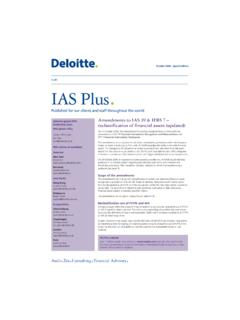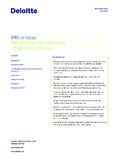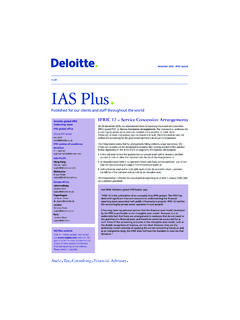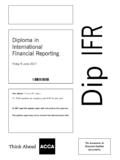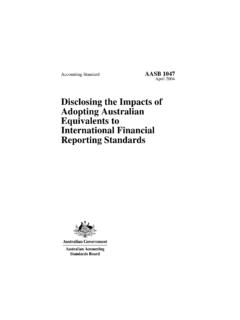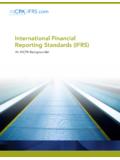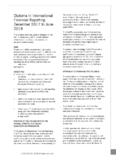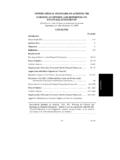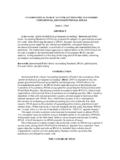Transcription of First-time adoption of International Financial …
1 First-time adoption of International FinancialReporting StandardsA guide to IFRS 1 November 2009 ContactsGlobal IFRS leaderKen centres of excellenceAmericasNew YorkMontrealRobert UhlRobert PacificHong KongMelbourneStephen TaylorBruce Peter LarsenAndreas BarckowGraeme PooleCleber CustodioLaurence s provides comprehensive information about International Financial reporting in general and IASB activities inparticular. Unique features include: daily news about Financial reporting globally. summaries of all standards , Interpretations and proposals.
2 Many IFRS-related publications available for download. model IFRS Financial statements and checklists. an electronic library of several hundred IFRS resources. all Deloitte Touche Tohmatsu comment letters to the IASB. links to several hundred International accounting websites. e-learning modules for each IAS and IFRS at no charge. information about adoptions of IFRSs around the world. updates on developments in national accounting most users of Financial statements, the term IFRSs is quite familiar: International Financial reporting standards have been the subject of globalnews headlines for several years now.
3 The spotlight first shone on IFRSs in 2001, when the European Commission announced that all entities listedon European stock exchanges would be required to adopt IFRSs by 2005. Since then, IFRSs have attracted attention on a regular basis including,more recently, as part of the discussion of the role of accounting standards in the current global Financial crisis. The movement of more and more jurisdictions towards a single, globally accepted, high quality set of accounting standards is proceeding at awelcome pace.
4 IFRSs are now in use for public reporting purposes in over 100 countries, including both developed and emerging are now firmly in the second wave of adoption , as other large countries such as Chile, Korea, India, Brazil and Canada have all announcedplans to adopt IFRSs in the near future. The signs are promising that the United States will also join this list although a formal date for adoptionhas not been announced, we are encouraged by the dialogue between the SEC and constituents, as well as the IASB and the FASB s continued jointprojects and progress towards guide to IFRS 1 First-time adoption of International Financial reporting Standardswas first published in 2004 with the aim of providing First-time adopters with helpful insights for the application of IFRS 1.
5 We are releasing this second edition with the same objective having updatedthe content to reflect the lessons learned from the first major wave of IFRS adoption in 2005, as well as for the changes to IFRS 1 since have structured the guide so as to provide users with an accessible reference manual: our executive summaryexplains the most important features of IFRS 1; section 2provides an overview of the requirements of the Standard; sections 3 and 4cover the specific exceptions and exemptions from IFRS 1 s general principle of retrospective application of IFRSs, focusingon key implementation issues; section 5addresses other components of Financial statements where implementation issues frequently arise in practice; section 6sets out Q&As dealing with specific fact patterns that users may encounter in practice.
6 And section 7discusses some of the practical implementation decisions faced by First-time matters addressed in this guide are intended to supplement the IASB s own guidance and act as an educational tool for the reader. However,this publication does not contemplate or address all possible fact patterns or industry-specific issues; therefore, it should not be considered adefinitive guide on all matters related to First-time adoption . Readers are encouraged to consult with a Deloitte professional to further discuss anyspecific issues, questions or hope that you will find this guide a useful tool in applying IFRS 1.
7 It is important to remember that IFRS 1 is not a static Standard. It wasintroduced to address the very real need to ease the burdens (both cost and effort) of transition for First-time adopters. As has been the case in thepast, as more entities move towards adopting IFRSs, it is possible that additional areas will be identified where the costs of application of IFRSs onfirst-time adoption exceed the benefits, in which case the IASB may introduce additional exemptions. Furthermore, as IFRSs continue to evolve,consequential amendments to IFRS 1 will be required.
8 To keep up to date on further developments in IFRS 1 as you move through your transitionjourney, or to learn more about IFRSs in general, we encourage you to visit our website, We believe that it is the mostcomprehensive source of news about International Financial reporting on the internet please check in WildGlobal Leader International Accounting StandardsDeloitte Touche TohmatsuWhich version of IFRS 1?In 2008, IFRS 1 was substantially rewritten (without altering the technical content) with the objective of making the Standard clearer and easier tofollow by reorganising and moving the exceptions and exemptions into appendices.
9 The improved structure is also intended to better accommodateongoing changes to the revised Standard is effective for periods beginning on or after 1 July 2009, with earlier application permitted. For simplicity, the structure of thisguide is based on the revised Standard, and references made are to the reorganised November 2008 and the date of writing (October 2009), IFRS 1 has been amended twice: in January 2009, an additional exemption was introduced as a consequential amendment of IFRIC 18 Transfers of Assets from Customers.
10 And in July 2009, additional exemptions were introduced relating to oil and gas assets, and arrangements involving additional exemptions are discussed later in this guide; readers should pay particular attention to their effective addition, readers should note that the May 2008 amendments to IFRS 1 and IAS 27 Consolidated and Separate Financial Statementsdealing withthe measurement of the cost of investments in subsidiaries, jointly controlled entities and associates (see section ) are effective for annual periodsbeginning on or after 1 July 2009.


